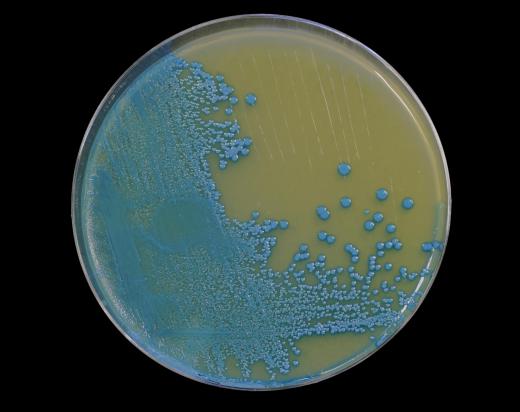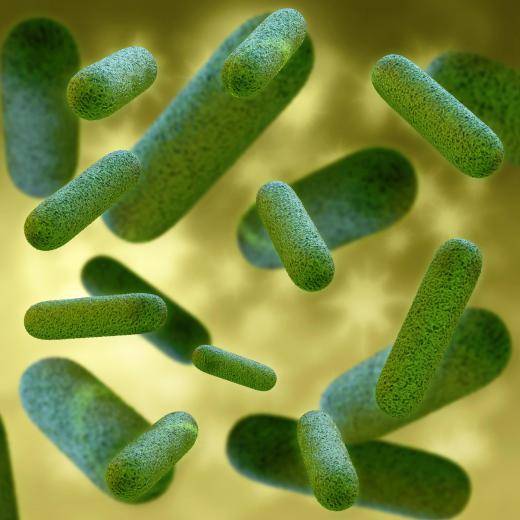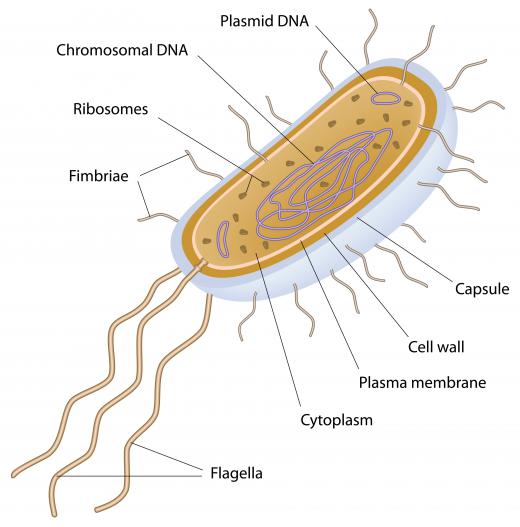What are Some Types of Bacteria?
Bacteria are the largest group of single-celled organisms on Earth, and make up the bulk of the world’s known biomass. There are an incredible number of types of bacteria on the planet, with the majority not yet classified. A number of what were once considered bacteria are, since the 1990s, now considered part of a separate domain, that of archaea.
Different types of bacteria can have vastly differing characteristics, with the main common trait being their lack of a differentiated nucleus. Different phyla are generally classed into two different groups as either having an outer membrane or lacking an outer membrane, with a number of phyla as yet undetermined. Some bacteria are incredibly small, such as those in the genus Mycoplasma, which are as tiny as the largest viruses, at around 0.3 micrometers. Others are relatively gargantuan, such as Epulopiscium fishelsoni, which can actually be visible to the naked eye, although still very small at about 0.5 millimeter (0.019 inches) in length.

There are two main types of bacteria in terms of shape: bacilli and cocci. The cocci are spherical bacteria, while the bacilli are shaped like rods. A third, smaller group, consists of bacteria that form in spiral formations, known as spirilla. In addition to these main groups, there are some stranger variations, such as those that look like commas, plant leaves, or even long drawn-out ladders. The different types of bacteria tend to group in different ways, with the same base shape determining which larger grouping they are a part of.

Bacilli, for example, can be singular or linked together in chains. Bacillus itself is a single, slightly rounded, rod-shaped bacteria. Coccobacillus, on the other hand, is also a single node, but it is much more of an oval shape. Diplobacteria looks like two Bacillus connected end to end. Streptobacteria is a long chain of bacilli, end to end. There are countless of types that have slight variations on this basic bacilli formation.

Cocci, similarly, have different configurations. Coccus itself looks like a single circle, while Diplococci looks like two Coccus stuck together. Streptococcus, the bacteria responsible for Strep throat, looks like a long chain of cocci together, while Staphylococcus, the bacteria responsible for Staph infection, looks like a cluster of grapes.
Among the many types of bacteria, only a few are harmful to humans. The majority are relatively innocuous, while some are actually helpful. Many, for example, live in the digestive tract, and help to digest food. Other bacteria live on the skin and fight off different harmful fungi. Still others live around mucus membranes, keeping other harmful membranes from taking up residence. In fact, the average human body contains some ten times more bacterial cells than it does actual human cells, the majority of which do good work for the body.

Some types of bacteria, however, are harmful to humans. Best known of these are probably Staphylococcus and Streptococcus. Others include Campylobacter, which is the main cause of food poisoning among humans. Another well-known historical bacteria is Yersinia pestis, a bacteria found in fleas that transmits the Bubonic plague to human beings.
AS FEATURED ON:
AS FEATURED ON:
















Discussion Comments
During my practicals, I observed gram positive oval rods, or the coccoid-bacilli. These are not corynebacteria and came out to be citrate and oxidase positive. Do the bacteria change their morphology with time? Do coccoid-bacilli maorphology exist?
Please, I need somebody to advise me. I was suffering from pain everywhere in my body and I have had a lot of tests and all of them are OK. But out of those tests, only one test, which is a urethral swab which shows scanty gram positive cocci.
But I don’t know. The doctor told me this is normal and then I did not believe and I did some research about what is cocci and I found out from a lot of websites that cocci can cause diseases.
By the way, from the swab itself, the lab did a culture but no pathogens isolated and neisseria gonorrhea is also not isolated. From my research on the web sites about such situations, I think I need to do the same test in order to check whether I have other harmful cocci bacteria such as Staphylococcus and Streptococcus. Please advise me if this is right, and thanks lots.
One thing to remember is that although most of the bacteria we encounter are good, there are several serious types of bacteria infections.
For instance, most people have heard of MRSA. This is a serious strain of bacteria that can cause a nasty infection that's difficult to treat.
MRSA can show up in cysts, and can go through the respiratory system as well as the urinary tract. The best way to avoid MRSA is simple hygiene and cleanliness.
Other kinds of bacterial infections are caused by types of bacteria called gram negative bacteria.
Around 90% of gram negative bacteria are considered harmful to humans, and can cause endotoxic shock.
The best way to avoid being infected is again, hygiene, and following appropriate blood pathogen precautions.
Can somebody tell me what 3 different types of good bacteria are? I need to know for my biology unit.
If you could also tell me what makes a bacteria cell different from any other cell, I'd love that.
Thanks!
This was such an informative article -- I really like how you mentioned that there are good bacteria as well as bad bacteria. I know that what with all the news about e.coli bacteria and even those types of flesh eating bacteria, it's easy to just think of all bacteria as bad, when in fact they're really quite helpful organisms.
Post your comments